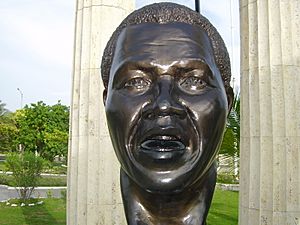Benkos Biohó facts for kids
Quick facts for kids
Benkos Biohó
|
|
|---|---|

Statue of Benkos Biohó
|
|
| Born |
Bissagos Islands, Guinea Bissau
|
| Died | 16 March 1621 |
| Other names | King of Arcabuco |
Benkos Biohó (who lived in the late 1500s and early 1600s), also known as Domingo Biohó, was a brave leader from Africa. He was taken from his home and forced into slavery. He managed to escape from the port city of Cartagena with ten other people. Together, they started a new settlement called San Basilio de Palenque. This place was known as the "village of the maroons" (people who escaped slavery). It is located in what is now northern Colombia.
In 1713, the King of Spain officially declared San Basilio de Palenque the first free village in the Americas. This happened because the Spanish troops could not defeat the maroons in their strong mountain hideaway.
Contents
Who Was Benkos Biohó?
Benkos Biohó was born into a royal family in Guinea Bissau, a country in Africa. He was from the Mandinka people.
His Journey to Freedom
In 1596, Benkos Biohó was captured by a Portuguese slave trader. He was then sold to different people. Eventually, he was brought to what is now Colombia in South America.
His first chance to escape came when the boat carrying him down the Magdalena River sank. He was caught again, but he did not give up. In 1599, he escaped once more. He found refuge in the swampy lands southeast of Cartagena.
Building a Community
Benkos Biohó was a great organizer. He built an army that became very powerful in the Montes de María region. He also created a secret network to gather information. This network helped other enslaved people escape and guided them to the free territory. This liberated area was known as a settlement or "palenque." Benkos Biohó was seen as the leader, using the title "king of Arcabuco."
A Peace Treaty
On July 18, 1605, the Governor of Cartagena, Gerónimo de Suazo y Casasola, realized he could not defeat Benkos Biohó and his people. So, he offered them a peace treaty.
The treaty recognized the freedom of the Matuna Bioho Palenque. It even allowed Benkos Biohó to enter Cartagena armed and dressed like a Spaniard. In return, the palenque promised not to accept more runaway enslaved people or help others escape. They also agreed that Benkos Biohó would no longer be called "king" by them. The peace agreement was finalized in 1612.
The Treaty is Broken
Sadly, the Spanish broke the treaty in 1619. They captured Benkos Biohó when he was walking in the city. On March 16, 1621, he was put to death. Governor García Girón ordered his execution. He believed Benkos Biohó was too respected by the people. He worried that Benkos Biohó's influence would turn the African communities against the city.
This broken promise made people lose trust in the government.
Legacy of Freedom
By the late 1600s, the Montes de María region had over 600 maroons. They were led by Domingo Padilla, who called himself captain. His wife, Jane, was called viceroy. They successfully resisted further attempts by the colonial authorities to control them.
In 2005, San Basilio de Palenque was recognized by UNESCO as a Masterpieces of the Oral and Intangible Heritage of Humanity. This means it is a very important place for human culture and history.
Today, about 80 kilometers (50 miles) east of Cartagena, you can still find hills that were important lookout spots for the runaway communities. These hills still carry the names of the old settlements, like Sincerin, Mahates, and Gambote.
See also
 In Spanish: Benkos Biohó para niños
In Spanish: Benkos Biohó para niños


